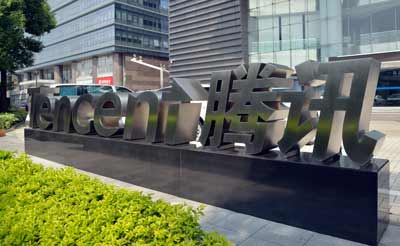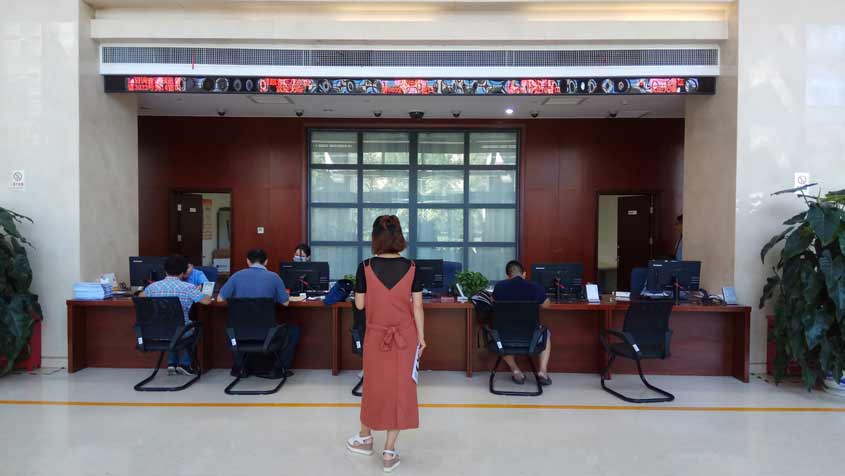
Trademarks and China’s business reform agenda
By Mr. Zhang Mao, Minister of the State Administration for Industry & Commerce, People’s Republic of China
As the global economy shows signs of recovery and digital technologies continue to transform industrial and business landscapes across the world, innovation – and the intellectual property (IP) rights that protect it – remain key drivers of economic development.

applications and registrations. Tencent is China’s top brand, valued at
USD 106.2 billion according to the BRANDZTM Top 100 Most
Valuable Chinese 2017 report (photo: Lou Linwei / Alamy Stock Photo).
Within this context, trademarks play a crucial role, particularly when it comes to bringing new products to market and supporting business growth. Trademarks enable customers to identify the products and services a company offers and help the company distinguish its goods and services from those of its competitors.
Trademarks are one of a number of IP rights companies can use to protect their innovative assets, strengthen their competitive position, expand their market share and improve their bottom line. Steadily increasing awareness of the value of trademarks and brands among Chinese entrepreneurs is enabling them to boost demand for and realize the market value of their innovative products.
The Chinese Government sets great store on trademarks and brands. Since the implementation of its 2009 Trademark and Brand Strategy, China has achieved remarkable results, meeting and surpassing established targets at every turn.
Reform of China’s business environment is continuing apace, generating important gains in many areas. New enterprises are forming at an unprecedented rate, and growing awareness of the value of trademarks among businesses and the general public is fueling record-breaking use of the trademark system.
For the past 15 years, China has topped global rankings for trademark applications and registrations. In 2016, the number of trademark applications and registrations rose to 3,691,000, representing an annual increase of 28.35 percent.
All indicators suggest this upward trend will continue. In the first six months of 2017, the State Administration for Industry & Commerce (SAIC) received 2,276,000 trademark applications and processed 1,211,000 registrations, with 13,452,000 registered marks currently in force, including 3,625 registered geographical indications, collective trademarks and certification marks.
Moreover, in the same period, the number of trademarks owned per 10,000 market players rose to 1,448 from 1,074 in 2011 – a growth rate of 34.8 percent. In China today, there is one registered trademark for every 6.9 market players.
The rapid development of China’s trademark and branding landscape is the result of sustained reform of the country’s business environment made possible by extensive and shared efforts of the Government, enterprises and society as a whole. A number of factors account for this remarkable transformation.
New business growth boosts use of trademarks
The Government’s drive to reform China’s business landscape took off in 2014 with the implementation of a series of measures, including lowering barriers to market access and boosting investment in startups. The aim was to inject new dynamism into the Chinese market and promote business growth.
Since then, unprecedented numbers of new businesses have sprung up, further boosting the uptake and use of the trademark system by Chinese firms.
By the end of 2016, the number of market players rose to 87,054,000, with 5,528,000 new enterprises registered in 2016 alone. This is equivalent to an average of 15,100 new enterprises registered every day, up from 12,000 per day in 2015 and more than double the number of daily registrations in the pre-reform period (6,900).
The number of newly registered individual businesses also rose dramatically to some 58,000,000 by the end of 2016, with more than 1,749,000 specialized agricultural cooperatives registered in the same year. This growth momentum is set to continue for some years to come.
The emergence of large numbers of new market players brings immense vitality to Chinese entrepreneurship and innovation and, with it, the need for an effective trademark registration system.
China’s trademark registration services improve
A major overhaul of China’s trademark registration system has been ongoing since 2014, when the SAIC began working to develop and provide users with a more streamlined, efficient, user-friendly and cost-effective trademark registration system.
To encourage uptake and use of the system, the Government has steadily lowered trademark registration costs. These have gone down from RMB 1,000 in 2013 to RMB 300 in 2017.
Reforms of the trademark examination process, including the introduction of a law to shorten the period of examination to under nine months and the launch of an online trademark registration service, have also helped to boost the system’s use. In the first six months of 2017, online trademark applications accounted for over 87 percent of all applications filed, representing a 10 percent increase on figures for the same period in 2016.
Evidence of brand value boosts trademark use
Growing evidence of the brand value that can be created by registering trademarks is also driving uptake of the system in China. Awareness of the rising value of Chinese brands is growing in all sectors of society and the economy. In 2012, just one Chinese brand appeared in global consulting firm Millward Brown’s list of the world’s top 100 brands. In 2017, 13 Chinese companies are featured.
An enterprise’s trademarks and brands encompass its commercial reputation, underpin its economic value, and have an important bearing on the productivity and performance of a business and the way it manages its assets.
SAIC is actively supporting local companies in their attempts to enhance business value through pledge financing. This enables enterprises to secure loans against their trademark assets. In this way, the value of their brands is factored into the enterprise’s capital worth.
In 2016, SAIC handled 1,410 trademark pledge registration applications, helping enterprises raise RMB 64.99 billion in financing. As at June 30, 2017, 410 pledge registrations have been processed, enabling enterprises to raise RMB 14.94 billion. These types of measures are enhancing both awareness of and the value of trademarks and brands across the business community.
Building a competitive business environment
China’s remarkable achievements in the area of trademark protection are fostering a competitive environment for brand development and economic growth.
Administrations for industry and commerce (AICs) across the country are committed to strengthening compliance with trademark law through a series of special measures with a view to ensuring effective market order. AICs, law enforcement authorities, customs and courts covering both administrative and judicial areas are working together to crack down on trademark infringements and counterfeiting. Greater awareness among enterprises of the importance of trademark and brand protection is also a positive force in terms of tackling such infringing uses, as is an increased awareness among the public of the need to respect IP rights in general.
Chinese brands go global
Rapid growth of the Chinese economy and the internationalization of Chinese brands have also boosted China’s use of WIPO’s Madrid System for the International Registration of Trademarks. According to WIPO, in 2016 for the first time China ranked among the top five countries using the Madrid System. In that year, Chinese applicants submitted 3,200 international trademark applications under the System – a year-on-year increase of 68.6 percent.
Also in 2016, foreign applicants sought to protect some 22,314 trademarks in China through the Madrid System. For the 12th consecutive year, China was the most designated country by foreign trademark applicants under the Madrid system.

China celebrates its brands
Brands underpin the competitiveness of an enterprise and a country. Recognizing their economic importance, the State Council is implementing its trademark and brand strategy within the period of The 13th Five-year Market Supervision Plan (2016-2020). In this context, as of 2017 “Chinese Brand Day” will be celebrated annually on May 10. The aim here is to further deepen understanding of the importance of registering trademarks and building brands, and to support of the Government’s continued reform of the country’s business landscape. It will also enable us to take advantage of every opportunity to raise awareness of the importance of trademarks and brands, for example through the implementation of the country’s national IP and innovation-driven development strategies and the “Belt and Road Initiative”. Guided by this market-oriented reform, SAIC will continue to improve its trademark registration services in support of business growth and the emergence of a broad range of Chinese trademarks that are recognized by consumers around the world.
AICs have an important role to play in this endeavor, for example through active implementation of trademark and brand strategies to ensure trademarks continue to drive China’s economic growth and transformation. Our common aim is to better serve “mass entrepreneurship and innovation” in support of advancing and upgrading the demand and supply structure of China’s economy.
SAIC will continue to ensure effective regulation of the trademark system and to deliver a better public service by supporting the development a cost-effective, user-friendly and efficient trademark registration system in China. We will reinforce existing procedures for the protection of registered trademarks by developing and implementing innovative and effective supervision mechanisms and processes, including for credit monitoring. And we will ensure greater coherence between Government authorities, enterprises and the market, encouraging the business initiative of enterprises and cooperatives to build an integrated national brand development system. We will also support efforts to build local brands in line with the philosophies of “innovation, coordination, eco-friendliness, opening-up and sharing”.
And we will make every effort to enhance the international competitiveness of Chinese enterprises and their brands, supporting and guiding them as they “go global” and encouraging them to strengthen the competitiveness of Chinese brands in international markets.
The WIPO Magazine is intended to help broaden public understanding of intellectual property and of WIPO’s work, and is not an official document of WIPO. The designations employed and the presentation of material throughout this publication do not imply the expression of any opinion whatsoever on the part of WIPO concerning the legal status of any country, territory or area or of its authorities, or concerning the delimitation of its frontiers or boundaries. This publication is not intended to reflect the views of the Member States or the WIPO Secretariat. The mention of specific companies or products of manufacturers does not imply that they are endorsed or recommended by WIPO in preference to others of a similar nature that are not mentioned.